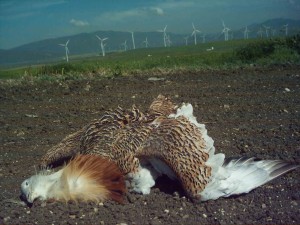The problem with wind farms: All those dead birds

LET’S SEE THE DOCUMENTS: A U.S House committee wants the Obama administration to hand over documents over protected birds such as bald eagles that are killed by wind turbines.
By Rob Nikolewski │New Mexico Watchdog
SANTA FE, N.M. — A U.S. House committee wants to see documents related to charges the Obama administration is more concerned about protecting the wind-farm industry than eagles and other protected birds.
The birds die in the rotors of the giant turbines that dot the U.S. landscape, particularly in the Southwest.
A birding activist in New Mexico wants to get to the bottom of the controversy.
“It’s inexcusable that any industry could have a pass to kill without recompense,” said Gail Garber of Albuquerque.
Earlier this week, the House Natural Resources Committee issued the subpoena as part of a 10-month investigation into the enforcement policies and practices of the U.S. Fish & Wildlife Service and the Justice Department.
The committee wants to force the Obama administration to hand over uncensored, internal documents to learn whether the administration is uniformly following environmental regulations when it comes to “avian mortality.”
“There are serious concerns that the Obama Administration is implementing these laws in an arbitrary fashion,” the committee’s chairman, Rep. Doc Hastings, R-Wash., said in a news release. “The administration has repeatedly chosen to only prosecute select violations.”
It’s been estimated 573,000 birds are killed each year after striking wind turbines, including 83,000 raptors, many of which are protected species, such as bald eagles.
In December, the administration, through the U.S. Department of the Interior, announced it would allow wind and solar companies to obtain permits for up to 30 years to protect them from penalties from accidentally killing or injuring protected birds.
“They gave them a pass, which is just outrageous,” said Garber, executive director of a conservation nonprofit called Hawks Aloft. She said she was was speaking for herself, rather than her organization. “To give them a blanket permit is just wrong.”
The Obama administration said it made its ruling because wind farms are considered a clean energy source.
Last year, an investigation by Associated Press alleged the administration was giving a pass to the wind farm industry, which the AP described as ”a green industry that’s allowed to do not-so-green things.”
The issue has put environmental groups in an awkward position because they overwhelmingly support renewable energy sources, yet their memberships are deeply concerned about protecting species and habitats.
“Instead of balancing the need for conservation and renewable energy, Interior wrote the wind industry a blank check,” National Audubon Society President and CEO David Yarnold said, referring to the industry’s 30-year waiver.
“It’s really going to be a very big issue as we move forward with alternative energy,” Bryan Bird, program director at Wild Earth Guardians in Santa Fe, told New Mexico Watchdog. “You’re onto something interesting … We’re taking it very seriously.”
The rotors on the turbines at wind farms appear to move slowly but can create tornado-like vortexes and reach speeds up to 170 mph. Conservationists say some of the farms are in the flight path of migrating birds.
The death rate in New Mexico is difficult to pinpoint, Garber said, because most of wind farms sit on private land.
While bald eagles are scarce in the state, golden eagles can be found throughout New Mexico — in the Upper Rio Grande Gorge, in particular. Garber said her group can account for 18 golden eagles in that region that “might produce one fledging per year” among them.
Nationwide, federal biologists say at least 85 eagles in 10 states have been killed by wind farms since 1997 — including 79 golden eagles — and that New Mexico ranked third in incidents of eagle deaths.
Construction on a wind farm is under way in Torrance County and going forward, Garber said. “The most important thing is pre-siting assessment. Have an outside assessment done by a qualified biologist … to determine if that site is suitable for development.”
Bird supports the House committee’s investigation. “The more transparency the better, and if it’s getting to the bottom of protecting species, we’re all for it.”
Contact Rob Nikolewski at rnikolewski@watchdog.org and follow him on Twitter @robnikolewski
The post The problem with wind farms: All those dead birds appeared first on Watchdog.org.







